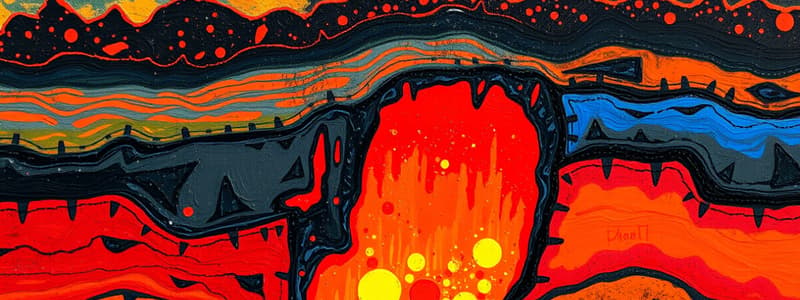Podcast
Questions and Answers
What is the primary source of Earth's internal heat?
What is the primary source of Earth's internal heat?
- Residual heat from formation and radiogenic heat (correct)
- Solar radiation
- Chemical reactions in the crust
- Wind and ocean currents
How does the distribution of internal heat vary across the Earth's layers?
How does the distribution of internal heat vary across the Earth's layers?
- Heat only exists in the crust
- Heat is uniformly distributed throughout all layers
- Heat increases deeper into the Earth with variation in composition (correct)
- Cooling occurs uniformly in all layers
What effect do convection currents in the mantle have?
What effect do convection currents in the mantle have?
- They cause the solidification of all rocks
- They eliminate volcanic activity
- They influence the movement of tectonic plates (correct)
- They maintain a constant temperature in the mantle
How do differences in magma composition affect volcanic eruptions?
How do differences in magma composition affect volcanic eruptions?
What role do gases play in magma formation?
What role do gases play in magma formation?
What is the classification of igneous rocks based on the cooling rate?
What is the classification of igneous rocks based on the cooling rate?
Which theory suggests that Earth's features are a result of internal heat processes?
Which theory suggests that Earth's features are a result of internal heat processes?
What is a protolith in the context of metamorphic rocks?
What is a protolith in the context of metamorphic rocks?
What are the three classifications of plate boundaries associated with magmatism?
What are the three classifications of plate boundaries associated with magmatism?
What causes the melting of rocks in the Earth's interior?
What causes the melting of rocks in the Earth's interior?
Which factor primarily leads to adiabatic decompression in rocks?
Which factor primarily leads to adiabatic decompression in rocks?
What is magmatism primarily characterized by?
What is magmatism primarily characterized by?
What role do volatiles play in the formation of magma?
What role do volatiles play in the formation of magma?
What forms as a result of hot mantle rock penetrating the crust?
What forms as a result of hot mantle rock penetrating the crust?
Which of the following gases are considered volatiles in the formation of magma?
Which of the following gases are considered volatiles in the formation of magma?
Which theory posits that the Earth’s crust is formed primarily from internal processes?
Which theory posits that the Earth’s crust is formed primarily from internal processes?
What primarily contributes to Earth's internal heat production?
What primarily contributes to Earth's internal heat production?
Which statement accurately describes Earth's thermal budget?
Which statement accurately describes Earth's thermal budget?
What role does gravitational contraction play in the formation of planets?
What role does gravitational contraction play in the formation of planets?
What is the result of radioactive decay in unstable elements?
What is the result of radioactive decay in unstable elements?
What percentage of solar energy is typically absorbed by Earth and its atmosphere?
What percentage of solar energy is typically absorbed by Earth and its atmosphere?
Which factor does NOT significantly contribute to the heat in Earth's interior?
Which factor does NOT significantly contribute to the heat in Earth's interior?
How does the compaction of dust clouds contribute to heat generation?
How does the compaction of dust clouds contribute to heat generation?
What is radiogenic heat a byproduct of?
What is radiogenic heat a byproduct of?
Flashcards are hidden until you start studying
Study Notes
Earth's Internal Heat
- Internal heat drives geological processes such as plate movements, earthquakes, and volcanism.
- Primary sources of Earth’s internal heat include residual heat from gravitational contraction and extraterrestrial impacts, along with radiogenic heat from radioactive decay.
Residual Heat
- Earth formed through the accretion of particles from a rotating cloud, aligning with the Nebular theory.
- Kinetic energy from moving extraterrestrial objects converts to heat energy during planet formation.
- Gravitational contraction results from increased gravitational attraction, leading to the compaction of materials and heat generation.
Magma Formation
- Magma forms from partial melting of the mantle and crust, composed of liquids, gases, crystals, and rock fragments.
- Geothermal gradient indicates that temperature increases with depth, promoting melting of rocks.
Factors Affecting Magma
- Temperature: Higher temperatures at greater depths facilitate rock melting.
- Pressure: Decreased pressure leads to adiabatic decompression, reducing melting temperatures.
- Volatiles: Substances like water and carbon dioxide lower the melting point of rocks when they mix with hot mantle material.
Convection Currents and Tectonic Plates
- Internal heat drives convection currents in the mantle, influencing tectonic plate movements and the formation of geological features.
Types of Plate Boundaries
- Plate boundaries can be convergent (plates collide), divergent (plates move apart), or transform (plates slide past each other).
Earth's Thermal Budget
- Earth's thermal budget quantifies heat released at the surface and produced inside the planet.
- Approximately 30% of solar energy is reflected back to space, while 70% is absorbed by the atmosphere, land, and oceans.
Summary of Key Concepts
- Earth's internal heat is vital for dynamic geological processes.
- Residual heat and radiogenic heat are the primary contributors to this internal heat.
- Magma formation requires specific conditions related to temperature, pressure, and the presence of volatiles.
Studying That Suits You
Use AI to generate personalized quizzes and flashcards to suit your learning preferences.




